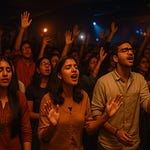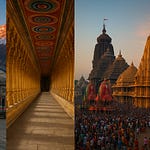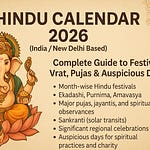Dakshineswar Kali Temple is one of India's most revered temples, dedicated to Goddess Kali. Situated on the eastern banks of the Hooghly River in Dakshineswar, Kolkata, this temple is known for its spiritual significance, stunning architecture, and historical importance. The temple holds a unique place in the Ramakrishna Paramahamsa movement, making it a sacred pilgrimage site for devotees worldwide.
History and Origin of Dakshineswar Kali Temple
Foundation by Rani Rashmoni
The temple was founded by Rani Rashmoni, a wealthy and devout widow from the Mahishya community, in 1855. According to legend, Rani Rashmoni had a divine vision of Goddess Kali instructing her to build a temple on the banks of the Ganges (Hooghly River). Following this vision, she purchased 20 acres of land in Dakshineswar and commissioned the temple's construction, which was completed within eight years.
Connection with Sri Ramakrishna Paramahamsa
The temple gained prominence as the spiritual home of Sri Ramakrishna Paramahamsa, one of India’s most revered saints. Ramakrishna served as the temple’s priest and experienced profound mystical visions of Kali, leading him to spiritual enlightenment. His teachings later inspired Swami Vivekananda, shaping the Ramakrishna Mission.
Architecture and Structure
Dakshineswar Kali Temple is a stunning example of Bengal-style Navaratna (nine-spired) architecture. The temple complex is designed with a blend of grandeur and devotion, covering 20 acres of land.
Main Temple (Bhavatarini Kali Temple)
The sanctum sanctorum (Garbha Griha) houses the idol of Bhavatarini, a form of Kali, standing on Lord Shiva, symbolizing the divine cosmic balance.
The idol is made of black stone, adorned with gold ornaments and a silk sari.
Twelve Shiva Temples
There are 12 identical Shiva temples, built in Atchala (eight-roofed) Bengali-style architecture, lined along the riverfront.
These temples are dedicated to Lord Shiva, worshipped as lingams.
Radha-Krishna Temple (Vishnu Temple)
A separate temple dedicated to Radha and Krishna is also present within the complex.
This temple symbolizes the influence of Vaishnavism in Bengal.
Panchavati Garden
A sacred grove of five ancient trees where Sri Ramakrishna meditated and had divine visions.
The spot is a serene area for meditation and spiritual contemplation.
Rituals and Daily Worship
Daily Puja Schedule
Mangala Aarti: Early morning at 4:00 AM.
Nitya Puja: The main worship session, conducted around 9:00 AM.
Bhog Aarti: Midday offering of food to the deity at 12:00 PM.
Sandhya Aarti: Evening prayers and rituals at 6:30 PM.
Shayan Aarti: Nightly prayers before closing the temple at 8:30 PM.
Special Rituals
Kali Puja: Celebrated with grandeur during Diwali, where thousands of devotees gather.
Durga Puja: The temple also observes Navaratri, with special recitations and offerings.
Shivaratri: A night dedicated to Lord Shiva, with continuous worship and bhajans.
Janmashtami: Devotional events celebrating Lord Krishna’s birth.
Sri Ramakrishna Jayanti: The birthday of Sri Ramakrishna Paramahamsa is a significant event celebrated at the temple.
Festivals Celebrated at Dakshineswar Kali Temple
Kali Puja (Diwali Special)
The grandest festival of the temple.
The temple is beautifully decorated with lights, flowers, and diyas.
Special tantric rituals are performed to invoke the blessings of Maa Kali.
Durga Puja
A nine-day festival celebrating Goddess Durga, culminating in the immersion of idols in the Hooghly River.
Devotees flock in large numbers for blessings and prasad.
Shivaratri
Dedicated to Lord Shiva, where fasting and night-long prayers are observed.
The twelve Shiva temples are the main focus during this festival.
Sri Ramakrishna Jayanti
Marks the birth anniversary of Sri Ramakrishna Paramahamsa.
Devotional songs, bhajans, and lectures on his teachings are organized.
Visiting Information
Temple Timings
Morning: 5:00 AM – 1:00 PM
Evening: 4:00 PM – 8:30 PM
The temple remains closed from 1:00 PM to 4:00 PM for bhog preparation.
How to Reach Dakshineswar Kali Temple
By Train:
Nearest station: Dakshineswar Railway Station (1 km away).
Alternative: Howrah Junction (major railway hub, 12 km away).
By Metro:
Dakshineswar Metro Station (Connected to Kolkata Metro).
By Air:
Netaji Subhas Chandra Bose International Airport, Kolkata (12 km away).
By Road:
Well-connected by taxis, buses, and auto-rickshaws from Kolkata.
Significance of Dakshineswar Kali Temple
Spiritual Importance
The temple is a major pilgrimage center for devotees of Maa Kali.
It was the spiritual hub of Sri Ramakrishna Paramahamsa, influencing Swami Vivekananda and the Ramakrishna Mission.
The site is a place of meditation and enlightenment, drawing thousands of seekers and tourists.
Architectural Beauty
The Navaratna (nine-spired) temple is one of the finest examples of Bengali temple architecture.
The riverfront location adds to its scenic beauty and peaceful ambiance.
Dakshineswar Kali Temple is not just a place of worship but a spiritual epicenter that has inspired millions over the centuries. Whether you seek divine blessings, spiritual knowledge, or architectural beauty, this temple offers an unparalleled experience.
From its historical origins under Rani Rashmoni to the mystical experiences of Sri Ramakrishna, the temple remains an enduring symbol of faith, devotion, and enlightenment. If you are visiting Kolkata, a trip to Dakshineswar Kali Temple is a must for every spiritual traveler and devotee of Maa Kali.










